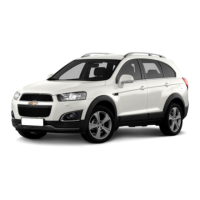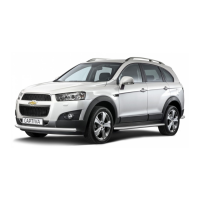Do you have a question about the Chevrolet Captiva 2007 and is the answer not in the manual?
Explains hazard messages and what to do to avoid or reduce them.
Overview of the vehicle's instrument panel layout and controls.
Explains the different types of keys and lock systems for the vehicle.
Details on theft-deterrent features like the vehicle alarm system.
Proper installation and adjustment of head restraints for occupant safety.
Guidance on proper use of safety belts, including for pregnant women.
Explanation of airbag types, deployment, and safety precautions.
Guidelines for restraining children of different ages and using child restraint systems.
Details on steering wheel adjustment, controls, horn, wipers, and washers.
Explanation of various warning lights, gauges, and indicators on the instrument panel.
Alerts to OBD II problems and potential damage to emission control system.
Alerts to potential problems with the vehicle's brake system.
Alerts to potential problems with the Antilock Brake System.
Indicates engine coolant overheating or cooling system problems.
Provides information about tire pressures and the TPMS.
Indicates a malfunction or need for Diesel Particulate Filter cleaning process.
Indicates issues with engine oil flow or pressure.
Indicates the engine is low on oil.
Displays when there is a noticeable reduction in vehicle performance.
Messages displayed in the cluster indicating vehicle status or actions needed.
Controls and operation of exterior lamps, including turn signals.
Operation of the AM-FM radio, including station search and presets.
Information on USB port, supported audio formats, and iPod/iPhone connectivity.
Playing music from a paired Bluetooth device.
Details on Bluetooth wireless technology and phone functions.
Steps to pair and connect Bluetooth devices to the infotainment system.
Making calls, switching calls, and redialing using the hands-free system.
Customizing infotainment system settings like time, date, language, and radio.
Setting up and using Android Auto and Apple CarPlay.
Controls for heating, cooling, and ventilation.
Operation of the dual zone automatic climate control system.
Tips for safe driving, including distracted driving and defensive driving.
Information on ABS, parking brake, and brake assist features.
Explanation of Traction Control, Electronic Stability Control, and Descent Control.
Operation, setting, and disengaging cruise control.
Details on Rear Vision Camera, Ultrasonic Parking Assist, and Side Blind Zone Alert.
Information on recommended fuel, additives, and filling the tank.
General information, driving tips, and weight considerations for towing.
Guidance on performing your own service work safely.
Guidance on keeping engine oil at the correct level and checking it.
Procedure and precautions for changing engine oil and filter.
Information on the system that indicates when to change engine oil and filter.
Information on coolant and antifreeze, including freeze protection.
Steps to take if the engine is overheating.
Information on brake and clutch fluid, including replacement intervals.
Information on battery types and replacing the battery.
Detailed steps for replacing the vehicle battery.
Procedure for replacing bulbs in headlamps, turn signals, and parking lamps.
Procedure for replacing bulbs in taillamps, turn signals, stoplamps, and back-up lamps.
Protection against electrical system overload using fuses and circuit breakers.
Checking and replacing fuses and circuit breakers.
Information on tires, including checking pressure, rotation, and replacement.
Information on the TPMS light and its meaning.
Information and warnings regarding the tire sealant and compressor kit.
Procedure for safely removing a flat tire and installing the spare.
Safe procedures for jump starting a vehicle with a dead battery.
Precautions and recommendations for towing the vehicle.
Warning against towing the vehicle from the rear due to potential damage.
Schedule of maintenance operations based on kilometers or time.
Information on using only tested and approved products.
Specifications for engine, performance, curb weight, and dimensions.
Information on checking and maintaining tire pressure.
Purpose and data recorded by the EDR in crash or near-crash situations.
Explains hazard messages and what to do to avoid or reduce them.
Overview of the vehicle's instrument panel layout and controls.
Explains the different types of keys and lock systems for the vehicle.
Details on theft-deterrent features like the vehicle alarm system.
Proper installation and adjustment of head restraints for occupant safety.
Guidance on proper use of safety belts, including for pregnant women.
Explanation of airbag types, deployment, and safety precautions.
Guidelines for restraining children of different ages and using child restraint systems.
Details on steering wheel adjustment, controls, horn, wipers, and washers.
Explanation of various warning lights, gauges, and indicators on the instrument panel.
Alerts to OBD II problems and potential damage to emission control system.
Alerts to potential problems with the vehicle's brake system.
Alerts to potential problems with the Antilock Brake System.
Indicates engine coolant overheating or cooling system problems.
Provides information about tire pressures and the TPMS.
Indicates a malfunction or need for Diesel Particulate Filter cleaning process.
Indicates issues with engine oil flow or pressure.
Indicates the engine is low on oil.
Displays when there is a noticeable reduction in vehicle performance.
Messages displayed in the cluster indicating vehicle status or actions needed.
Controls and operation of exterior lamps, including turn signals.
Operation of the AM-FM radio, including station search and presets.
Information on USB port, supported audio formats, and iPod/iPhone connectivity.
Playing music from a paired Bluetooth device.
Details on Bluetooth wireless technology and phone functions.
Steps to pair and connect Bluetooth devices to the infotainment system.
Making calls, switching calls, and redialing using the hands-free system.
Customizing infotainment system settings like time, date, language, and radio.
Setting up and using Android Auto and Apple CarPlay.
Controls for heating, cooling, and ventilation.
Operation of the dual zone automatic climate control system.
Tips for safe driving, including distracted driving and defensive driving.
Information on ABS, parking brake, and brake assist features.
Explanation of Traction Control, Electronic Stability Control, and Descent Control.
Operation, setting, and disengaging cruise control.
Details on Rear Vision Camera, Ultrasonic Parking Assist, and Side Blind Zone Alert.
Information on recommended fuel, additives, and filling the tank.
General information, driving tips, and weight considerations for towing.
Guidance on performing your own service work safely.
Guidance on keeping engine oil at the correct level and checking it.
Procedure and precautions for changing engine oil and filter.
Information on the system that indicates when to change engine oil and filter.
Information on coolant and antifreeze, including freeze protection.
Steps to take if the engine is overheating.
Information on brake and clutch fluid, including replacement intervals.
Information on battery types and replacing the battery.
Detailed steps for replacing the vehicle battery.
Procedure for replacing bulbs in headlamps, turn signals, and parking lamps.
Procedure for replacing bulbs in taillamps, turn signals, stoplamps, and back-up lamps.
Protection against electrical system overload using fuses and circuit breakers.
Checking and replacing fuses and circuit breakers.
Information on tires, including checking pressure, rotation, and replacement.
Information on the TPMS light and its meaning.
Information and warnings regarding the tire sealant and compressor kit.
Procedure for safely removing a flat tire and installing the spare.
Safe procedures for jump starting a vehicle with a dead battery.
Precautions and recommendations for towing the vehicle.
Warning against towing the vehicle from the rear due to potential damage.
Schedule of maintenance operations based on kilometers or time.
Information on using only tested and approved products.
Specifications for engine, performance, curb weight, and dimensions.
Information on checking and maintaining tire pressure.
Purpose and data recorded by the EDR in crash or near-crash situations.
| Brand | Chevrolet |
|---|---|
| Model | Captiva 2007 |
| Category | Automobile |
| Language | English |











